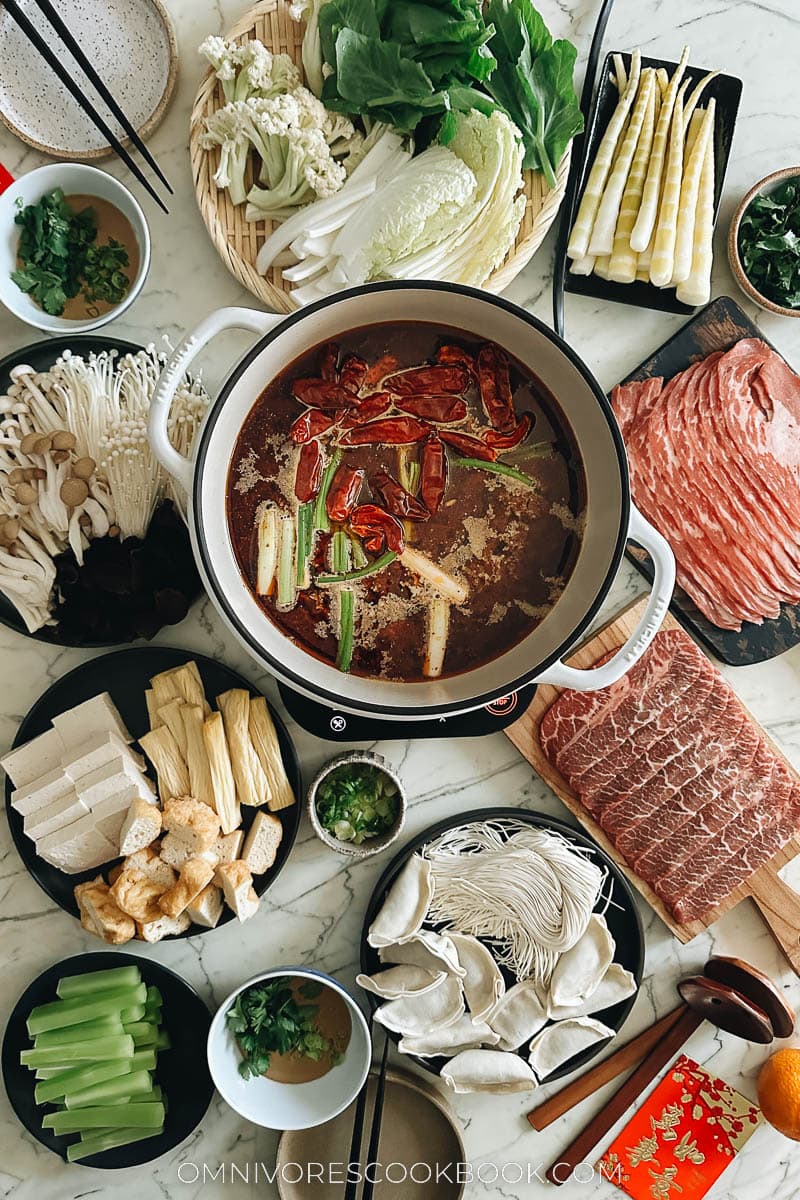
Table of contents
If there is one thing that might make a Chinese person happier than the Chinese New Year festival in the winter, it is a hot pot party. Like a summer barbecue, a Chinese hot pot party is as important as a social event as it is a meal, where friends and family gather and cook around a common pot while chatting and sipping beer. The great thing about a hot pot party is, it’s easy to prepare since your guests will do the cooking themselves. Plus, a group of people can share so many ingredients, so everybody has an opportunity to try out a variety of things, as well as enjoy their favorites.
What is Chinese Hot Pot?
Hot pot (火锅, Huo Guo) is a Chinese cooking method. A big pot containing boiling hot broth is set in the center of the table with a heating element underneath. Various raw ingredients are served on plates around the pot, such as thinly sliced meat, seafood, vegetables, tofu, dumplings, and noodles. The guests cook the ingredients in the broth and eat them with a dipping sauce.
There are many types of winter pot-based dishes across Asia, where many ingredients are added to a big pot and cooked in the center of the table. However, Chinese hot pot has a distinguishing characteristic – only a small amount of ingredients is added to the pot by the individuals at the table and cooked just long enough, then the food is taken out and consumed immediately before more ingredients are added.
This is the part that makes Chinese hot pot really easy to prepare as a host, since the host only needs to wash and cut the ingredients – no need to cook anything beforehand. Plus, the fact that the meal is cooked on the dinner table makes the eating process so much more fun. Because everyone will be able to select their favorite ingredients, cook them to the degree they prefer, and combine ingredients to make their own sauces.
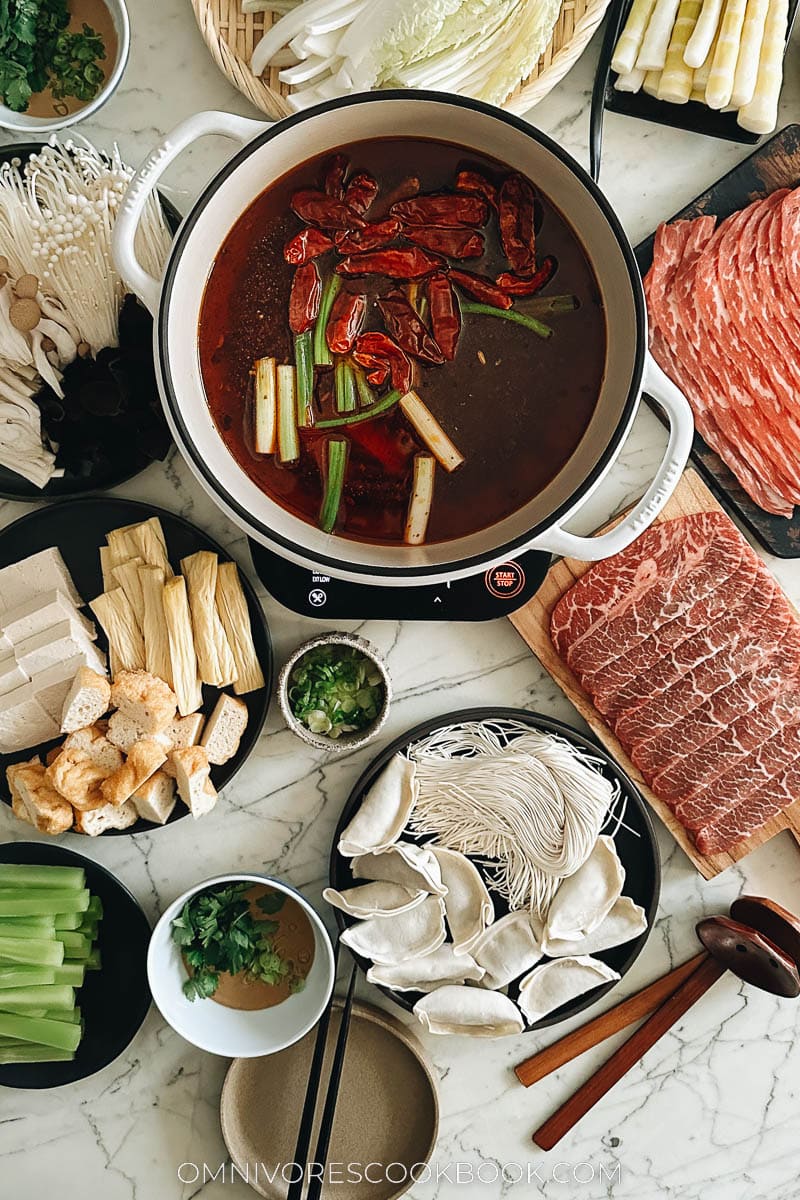
Hot pot soup base (火锅底料)
There are many different styles of hot pot in China and they vary depending on the region. The primary difference from region to region is the broth.
Choosing the type of broth is one of the most important considerations when planning a hot pot party, because all the food will be cooked in this broth. So it’s essential to choose a flavor that pleases all your guests.
Hot pot broth – buy or make your own?
Despite the fact that I enjoy making most of my Chinese food at home, I highly recommend you purchase a hot pot broth base. Depending on the type of broth you use, it could require so many special ingredients that are expensive to buy or unavailable at your local Asian market. A hot pot party is supposed to be easy to prepare and fun to host, so save yourself the trouble and buy the broth base in an Asian store or online.
That being said, I have tried making the most popular Sichuan Spicy Hot Pot Base and the result is amazing. If you’d like to try it out, check out the recipe!
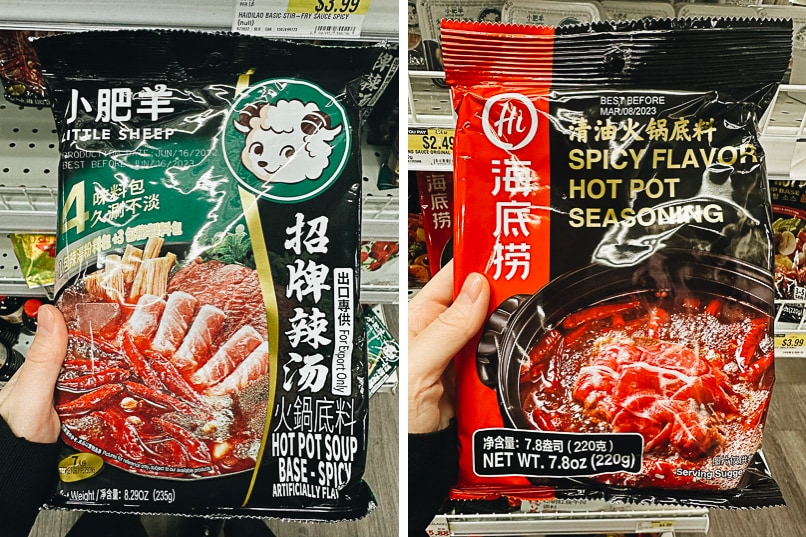
Spicy broth (麻辣底料)
One of the most popular broths across China and you can never go wrong with it. The spicy broth was a must-have in 99% of the hot pot dinners I’ve eaten. There are a few types of spicy hot pot base that you can choose from – Sichuan, Chongqing, and Mongolian style. The Sichuan and the Mongolian ones might be the most popular, but personally I prefer Chongqing style, which features a thicker, richer broth.
TIP
When I use a store-bought base, I usually like to throw in a few slices of ginger, green onions, and dried chili peppers (only if it’s a spicy pot) for a great presentation. Plus, the aromatics add more flavor to the broth.
Sichuan spicy hot pot base
Red chili oil (made with vegetable oil) based spicy broth is balanced with spiciness, numbness (from Sichuan peppercorns) and various herbs.
Recommended brands
Hai Di Lao – A famous Chinese brand that you can purchase in an Asian grocery store or on Amazon. The brand comes from a big hot pot restaurant chain that has hundreds of locations around China. Their hot pot base is one of our favorites.
Huangcheng Laoma – A famous hot pot restaurant in Sichuan that produces their own secret sauce. My friend Taylor at The Mala Market carries it in her online store.
Chongqing spicy hot pot base
Red chili oil base that is made with beef fat and very little in terms of spices. The aroma and flavor mostly come from the animal fat and chili peppers. The finished broth is usually oilier, spicier, and heavier than the Sichuan style.
Recommended brands
De Zhuang (德庄) – A Chongqing brand that is quite famous back in China. You can usually find it in Chinese markets
Qiao Tou (桥头) – Another Chongqing brand that I’ve tried in China. You can find their products on Amazon, as well.
Mongolian spicy hot pot base
Red chili oil base (using vegetable oil) that’s quite heavy on the cumin. The finished broth is less spicy and lighter than the Sichuan type.
Recommended brands
Little Sheep (小肥羊) – A famous Chinese restaurant chain that produces their own line of soup bases and sauces. You can find their products in many Asian grocery stores and on Amazon.
Clear broth (清汤底料)
Clear hot pot broth is the default type in northern China. Growing up in Beijing, this was the only broth I knew about until spicy broth took over the hot pot world. This is actually a broth we used to make at home, using simple ingredients such as water, scallions, ginger, peppers, shiitake mushrooms, and jujubes. However, nowadays, to make the broth more flavorful, I often use a packaged soup base.
You can easily find this broth base at an Asian market or online. Both Little Sheep and Hai Di Lao produce a plain hot pot soup base (shop on Amazon). I sometimes also buy the mushroom hot pot base, which can be used as a clear broth.
Other types
There are other types of hot pot base too, such as tomato, seafood, satay, and even soy milk. But to be honest, we rarely go for those. If you want to experiment with different soup bases, I highly recommend you purchase some and try them out before your party.
What hot pot base should I use?
Ideally, you can use a split pot (see the equipment section below) and serve two types of soup. In this case, you can use a spicy broth (the most popular) and a mild broth. The mild broth is designed to balance things out, in case you want a break from the spicy food. Plus, if you have a guest that does not eat spicy food, it’s very helpful to have the mild broth available.
If you do not own a split pot, you might consider using two pots, each with a different type of soup, depending on the size of your party.
How do you use a hot pot base?
Most of the time the hot pot base will have instructions on the back of the package. And usually one package is sufficient for one meal, diluted with 6 to 8 cups of water. Simply combine your hot pot base with water and heat it until boiling, then your dinner party is ready to start. During the cooking and eating process, the broth will reduce by quite a lot. When it’s reduced to about half, you should add more water and wait until it starts to boil again. Only cook ingredients when the broth is boiling, to ensure proper cooking.
Hot pot party equipment
Hot pot + portable gas stove
I highly recommend a split pot, which will allow you to serve two types of broth, like this one on Amazon. My friend Taylor at The Mala Market also carries this beautiful Stainless Steel Split Hot Pot, which is slightly pricier but very durable.
To use the pot, you’ll also need a portable stove to heat up the broth. I use the Iwatani gas stove, which heats up the pot very quickly. Don’t forget the canned butane, which you can easily find at Walmart or Home Depot.
Electric hot pot
Alternatively, you can use a split hot pot that comes with a heating element included, such as this beautiful Zojirushi split electric hot pot. An electric hot pot is a great investment if you like to cook hot pot more frequently. You can simply plug in the pot to get it started. The pot will be at eye level and easier to cook with because the heat source is integrated.
Ladle and bowls
Aside from the hot pot, be sure to prepare a slotted ladle on the side, so your guests can fish the cooked food out of the hot pot.
Make sure you also have lots of small bowls and plates for your guests. Everyone should have one to two small bowls for dipping sauce(es), and one plate for the food.
Dipping sauce
There are so many ways to make a hot pot dipping sauce. Here I want to introduce three types of sauces.
Sesame paste based sauce
This is the default hot pot sauce in northern China and it’s quite popular in other regions, too. It’s usually made with toasted sesame paste diluted with water, soy sauce, fermented tofu, fermented garlic chives (jiu cai hua), sesame oil, chopped cilantro, and green onions.
You can find my sesame hot pot dipping sauce recipe here.
Shacha sauce for seafood
A sauce that is perfect for seafood and very popular in Cantonese and Taiwanese restaurants. The sauce is made from fish paste and various spices, with a hint of sweetness. Since the paste is quite thick, you should use a bit of broth from the hot pot to thin it out a bit. You can buy the sauce in an Asian grocery store or on Amazon.
Garlic sesame oil
A “weird” and lesser-known sauce that I love. The sauce uses toasted sesame oil and finely grated garlic (ratio 1:1). It might sound intense, but it works perfectly with the Chongqing style spicy soup. To make it more approachable, add some sesame sauce, sesame oil, and a generous amount of garlic for a rich sauce.
For other sauce ideas, do check out the three dumpling dipping sauce recipes I shared in the past. They work well with hot pot, too.
When I serve the dipping sauces, I prepare a few things so my guests can mix and match as they like. They include: store-bought sesame paste, homemade chili oil, finely grated garlic, chopped green onions, chopped cilantro, toasted sesame oil, fermented tofu, light soy sauce, and Chinkiang vinegar.
Essential hot pot ingredients
I love shopping for hot pot ingredients because you have practically unlimited options. Here are a few food groups that I recommend. It’s almost impossible to make a grocery list when it comes to hot pot ingredients because each grocery store carries so many different things. You should check out each food group and try to get a few diverse items from each group.
Meat and seafood
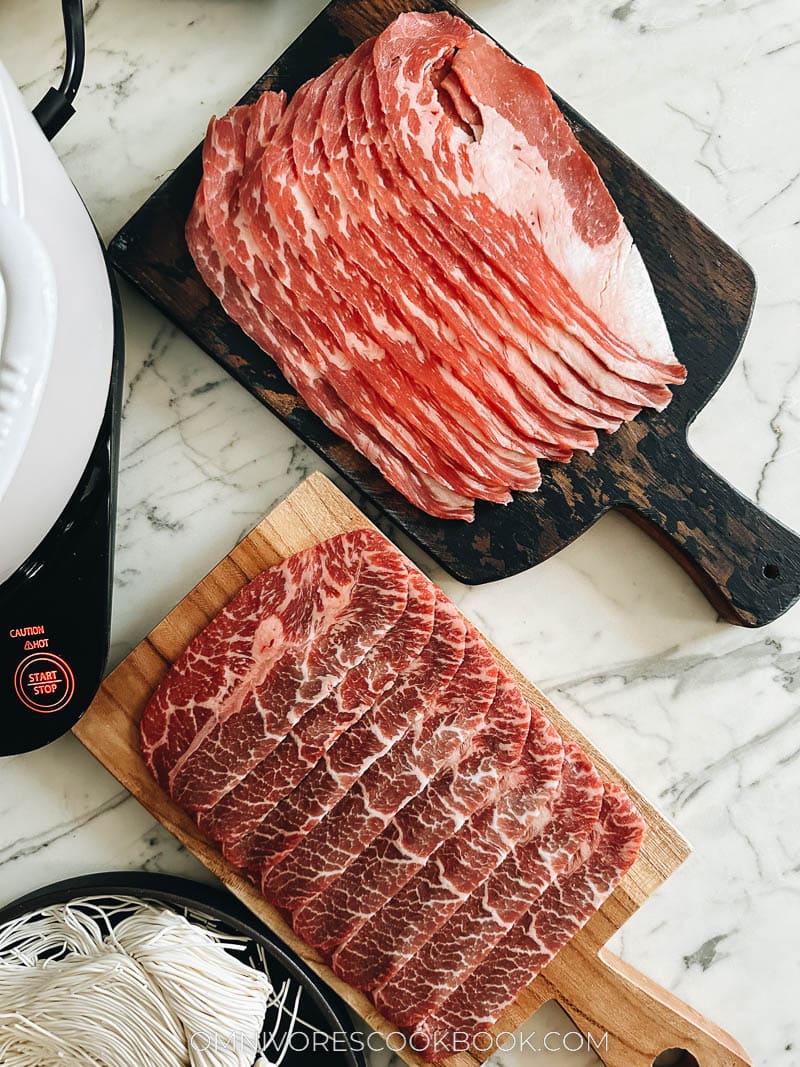
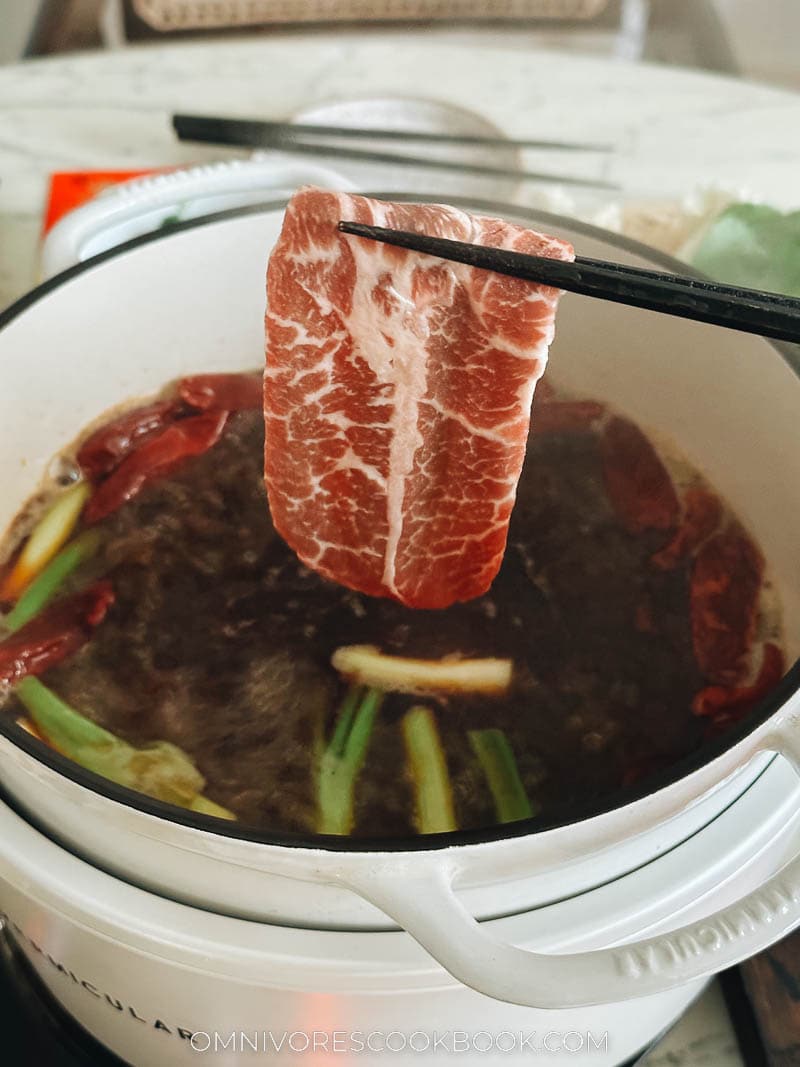
Some of my personal favorites include thinly sliced beef, sliced lamb, and fish balls. Here is a list of meat and seafood:
- Sliced lamb (shoulder, leg, or any well marbled slices)
- Sliced mutton
- Sliced beef (short ribs, ribeye, flank, sirloin, or other marbled cut)
- Sliced pork (loin, sirloin, shoulder or pork belly)
- Sliced chicken (breast or thigh)
- Fish balls
- Beef balls
- Sliced fish (white fish works the best, you can marinate them with Shaoxing wine, salt and cornstarch for a better texture)
- Squid, cuttle fish and scallops
- Shrimp
- Shrimp cake, fish cake, and fish tofu
It would be the most ideal if you have access to an Asian grocery store. Because you can find machine-sliced meat that is intended for use in hot pot. You can find these meats in the freezer section or refrigerated section. For the frozen type, the meat slices are rolled and packed in plastic containers. You can also use thinly sliced meat that is intended for Japanese shabu shabu or Korean BBQ.
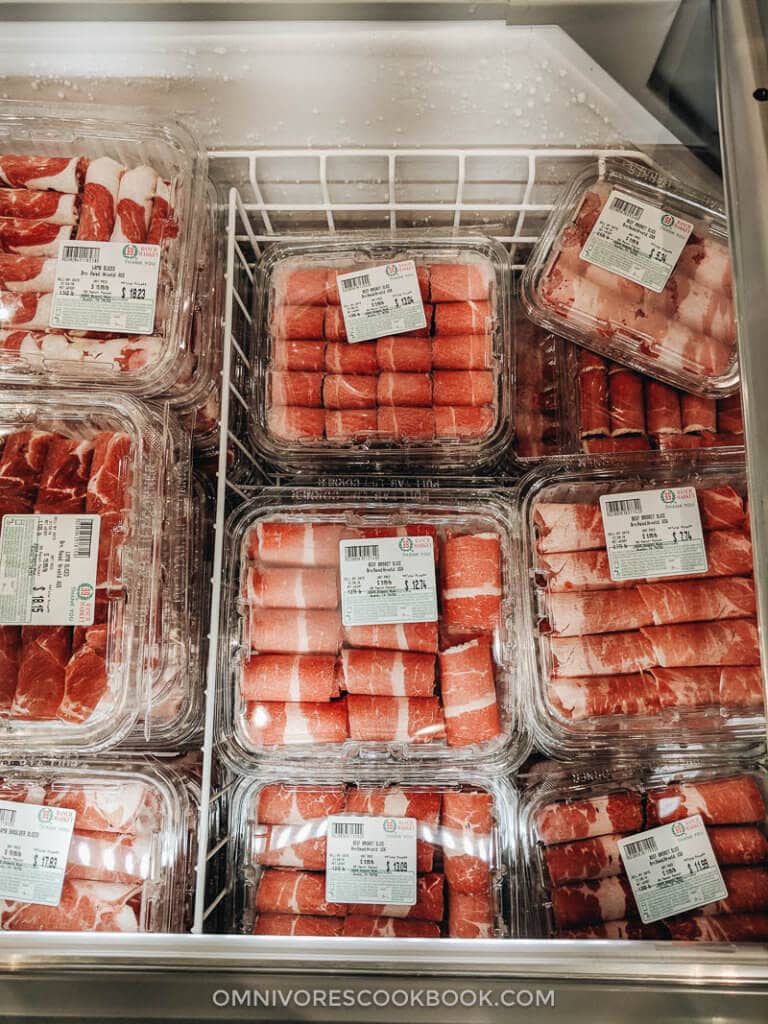

You can always buy the meat and cut it at home. In this case, you’ll want to buy some well-marbled meat and slice it as thinly as possible, so the cooked meat will remain juicy and tender.
Seafood such as shrimp, squid, and sliced fish filets all work well in a hot pot. But my personal favorite is fish balls, which you can find in the freezer section. 99 Ranch Market and H mart carry filled fish balls, with shrimp, pork and lobster. They are SO GOOD!
Cooking notes
One thing to remember is to never leave meat in the hot broth and forget about it. The thinly sliced meat usually needs less than 30 seconds to cook through. What I usually do is hold the meat with my chopsticks and dip it in the hot broth, then immediately take it out when the color has just changed to cooked (or medium rare, sometimes).
Seafood needs to be cooked according to the same rule, that you always want to keep an eye on it so it won’t overcook. Frozen fish balls require more cooking time, maybe 2 to 4 minutes, depending on their size.
Tofu and soy bean products
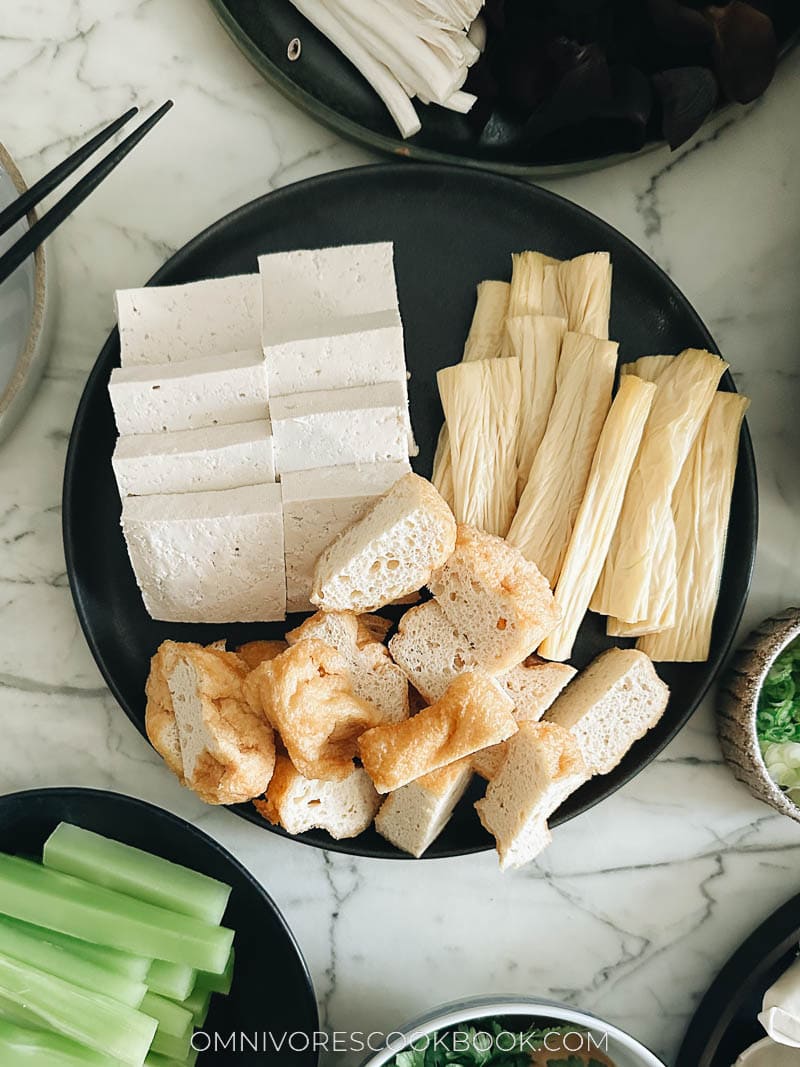
This food group is always a star at a Chinese hot pot party because there are so many varieties that offer different shapes and textures. All of them are made from soy beans but they have very different textures. The great thing is that they soak up flavor really well, so they taste so good when cooked in a hot pot.
- Blocks of tofu (firm or extra firm), sliced
- Yuba sheet (also called tofu skin in Chinese), sliced
- Tofu knots
- Tofu sticks
- Deep fried tofu puffs
- Frozen tofu, thawed and sliced
Tip: How to make frozen tofu
Buy some firm tofu and throw the package in the freezer for a day, then thaw it before using. This will change the structure of the tofu and create a very porous texture. This tofu works perfectly in a hot pot.
Tofu usually requires the longest cooking time. So it’s very common to add a few pieces at the beginning of cooking and fish them out after 10 minutes or longer, when you’re ready to eat them. The various tofu products require relatively little cooking time but they hold their shape well even when you cook them a bit too long. And they are edible even when cold, so they are ready to eat when tender and heated through.
Mushrooms
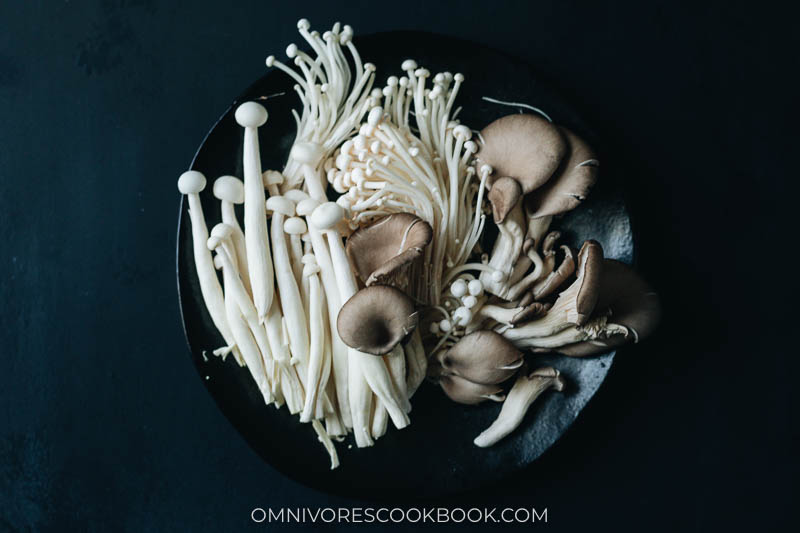
Another must-have on my hot pot table. Although regular white mushrooms work well, do venture out and try out some different types.
- Enoki (golden needle mushrooms), separated into smaller threads
- Shimeji, separated into smaller bunches
- King oyster mushrooms, sliced
- Shiitake mushrooms, sliced or halved
- Wood ear mushrooms, soak to rehydrate first
- Oyster mushrooms, separated into bite-size pieces
The smaller mushrooms only take 2 to 3 minutes to cook, versus the large shiitake mushrooms, which can take 5 minutes or more.
Leafy greens
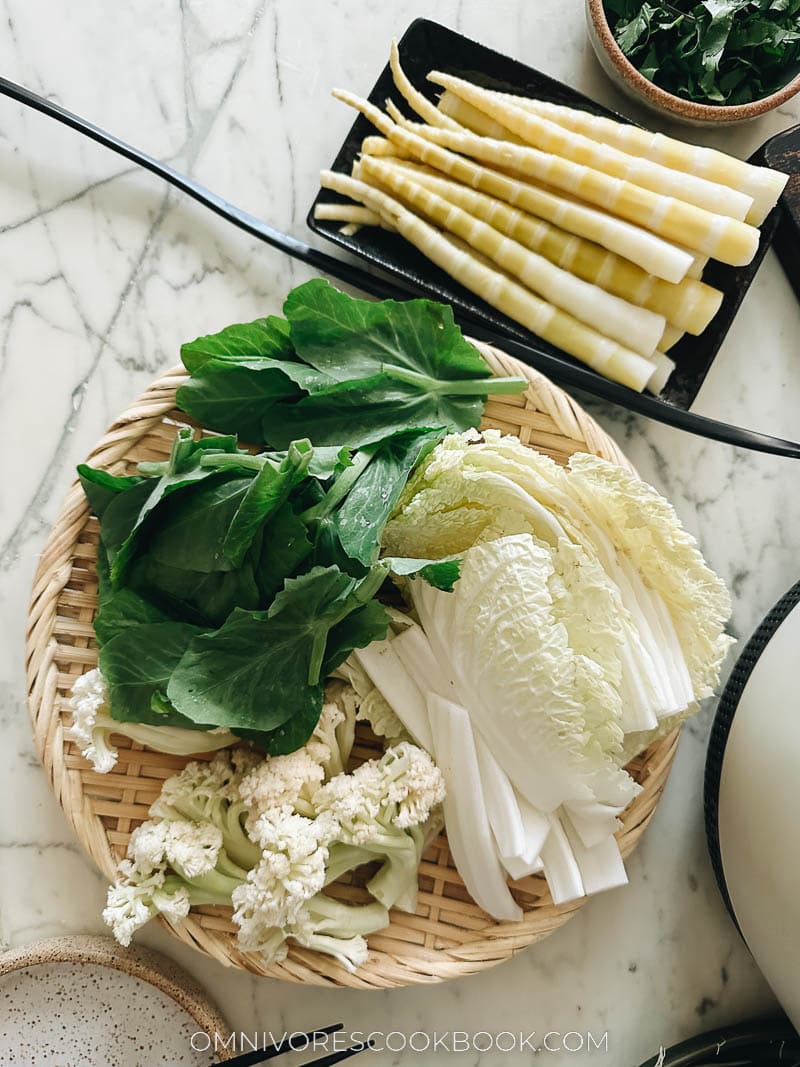
Not all vegetables are created equal when it comes to hot pot. Although you can almost use any vegetables in a hot pot, here are some of my favorites:
- Napa cabbage, sliced
- Baby bok choy, quartered or halved
- Chinese broccoli, Stem peeled
- Yu choy, tough ends trimmed and served whole or halved
- Spinach
- Snow pea shoots
- Watercress
- Chrysanthemum leaves
Note that some leafy greens such as spinach only need 30 seconds of cooking before they turn soft and are ready to eat. Meaty veggies such as bok choy and napa cabbage require more cooking, 2 to 4 minutes depending on their size.
Other vegetables
I always like to add a few other non-leafy vegetables, because they add great texture and work so well in a hot pot.
- Chinese cauliflower, separated into bite-size pieces
- Winter melon, sliced
- Celtuce, peeled and sliced
- Lotus root, sliced
- Bamboo shoots (sliced large bamboo shoot, or smaller long shoots served whole)
- Potato or sweet potato, sliced
- Daikon radish or other radishes, sliced
- Squash (Kabocha or other types), sliced
- Corn on the cob, cut to 2” (5 cm) long round pieces
Tender vegetables such as winter melon and celtuce takes 1 to 2 minutes to cook through. Root vegetables require even more cooking time, so just throw them into the broth and test their texture along the way.
Noodles and dumplings
Noodles and dumplings are considered staples in Chinese hot pot and are a must-have if you’re celebrating Chinese New Year.
- Hand-pulled noodles or other fresh noodles
- Packaged dried noodles
- Vermicelli noodles
- Rice noodles
- Shirataki noodles (konnyaku)
- Rice cakes
- Frozen dumplings (Highly recommend Wei Chuan dumplings)
For noodles and dumplings, simply cook them according to the instructions on the package.
There are two ways to serve the noodles.
- You can serve them with the hot pot broth. In this case, the noodles should be served at the beginning of the hot pot party, because the broth gets too cloudy after all the cooking. And it’s more common to serve the noodles in the non-spicy hot pot broth.
- You can also serve the noodles with hot pot dipping sauce. My sesame dipping sauce is perfect for this purpose.
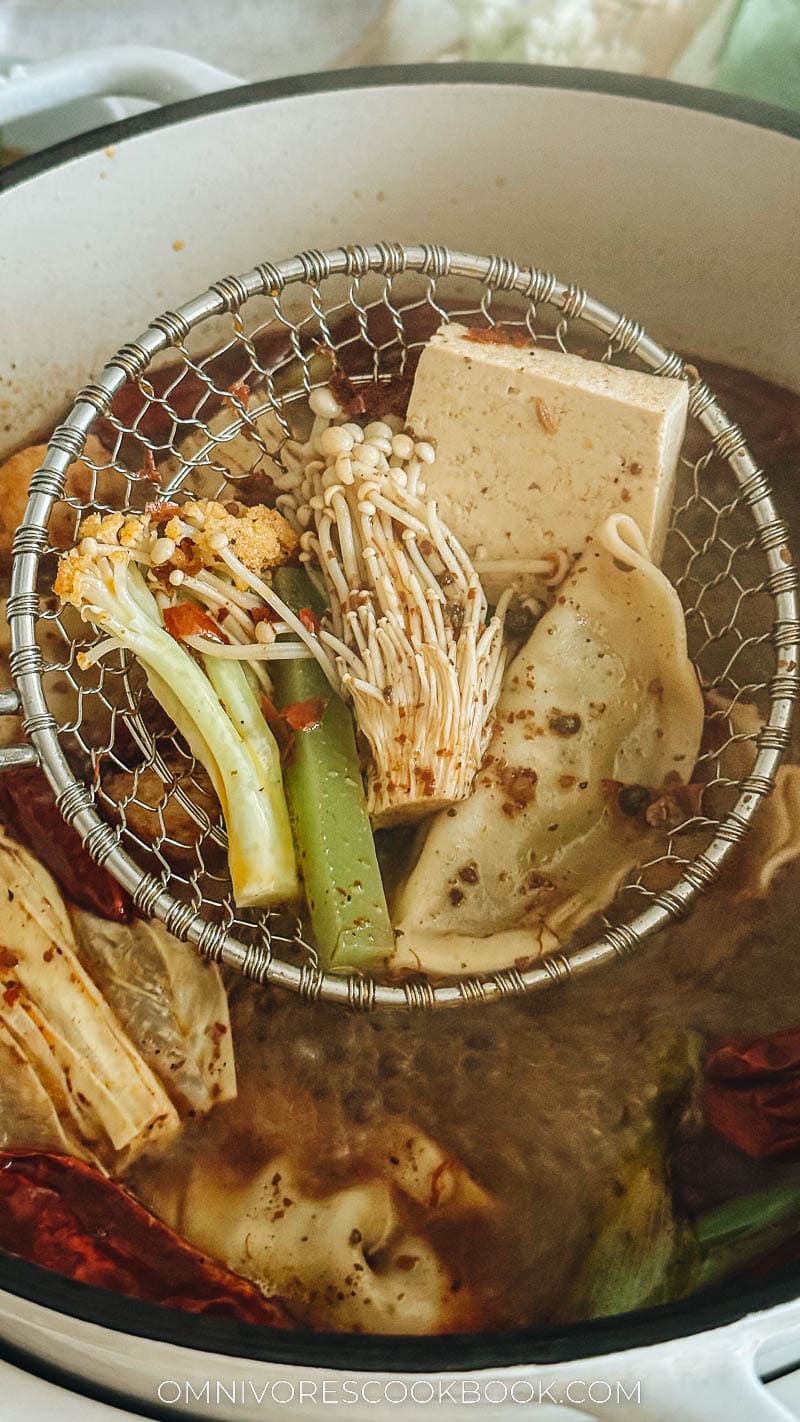
Hot pot party prep
The best thing about preparing a hot pot party is that it requires very minimal prep work. All you need to do is:
1. Make a plan
Consider the dietary preferences of your guests, then decide the type of soup broth you will serve.
Also, you need to plan based on the number of guests. A big hot pot usually serves six people perfectly, but could possibly serve eight. If you have more guests, you’ll need to consider setting up two hot pot sets, so your guests will have enough room to cook and will not be waiting forever for small amounts of food.
2. Shop for the ingredients
It would be the most convenient if you could access an Asian market where you can get everything in one trip. If there are no Asian markets where you live, you might want to plan a few days ahead and order some of the ingredients and equipment online.
When shopping for food for the hot pot, you simply need to consider the amount of meat and seafood. I usually prepare 4 to 8 ounces of meat and seafood per person. And I usually get 2 to 3 ingredients from each food group.
You can save all the leftovers and use them to cook soups and noodles in the days following the party.
3. Prep the ingredients
On the day of the party, wash and chop all the ingredients. Prepare the dipping sauces. Add the hot pot base and water into the hot pot, set it on the portable stove and place it in the center of the table. Prepare a slotted ladle on the side. Arrange all the ingredients around the pot. Prepare one to two small bowls, one plate, and one pair of chopsticks for each person.
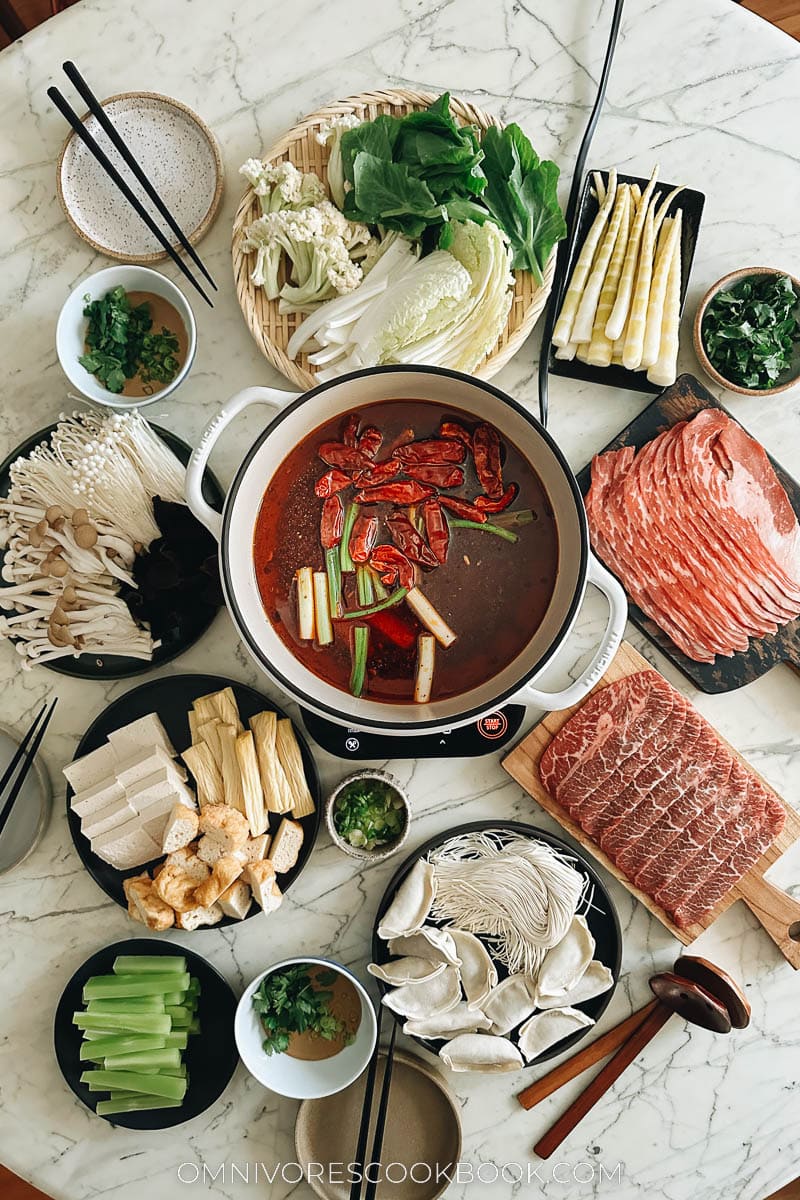
A few important rules when cooking hot pot
1. Be patient and wait until the broth is boiling
I know you’ll be tempted to start cooking right away, but remember to be patient and wait until the broth starts boiling. This way the food will be cooked quickly and remain juicy.
2. Add a small amount of food each time
Always remember – you’re not cooking a pot of soup. Only add the few pieces of food that you plan to eat in the next couple of minutes. Overcrowding the pot will cause the broth temperature to drop, so all the food will be cooked more slowly and may not be properly done.
3. Do not overcook
This is the most important thing and a lot of first timers forget it. Always keep an eye on the food you’ve just added and take it out when it is ready. Meat cooked in a hot pot is supposed to be soft and juicy, not hard and dry like cardboard.
4. Only cook the food you plan to eat
There are different table rules when it comes to hot pot. As a rule of thumb, you should only cook the food you yourself plan to eat. Sometimes the host will cook items for everyone. Or maybe a friend knows everyone’s preferences and throws in a few more items. But most of the time, everyone cooks only the items they plan to eat.
5. Sanitize your chopsticks
Since you’ll be using your chopsticks to pick up and cook raw meat, as well as serve the cooked food, it’s important that you dip the chopsticks in the boiling broth for a few seconds before picking up any cooked food. The hot broth will quickly sanitize your chopsticks to prevent food-related illness.
You can also prepare a few pairs of chopsticks for cooking and transfer them to individual serving bowls. And each guest would use their own pair for eating.
Chinese hot pot restaurants
Lastly, I want to list a couple of hot pot restaurants I like.
Little Sheep
If you’re in a major city in the US, chances are, you can find a branch of Little Sheep, a very famous Chinese chain that serves Mongolian style hot pot. You can use this store locator to find a location near you.
Hai Di Lao
It’s probably the most popular hot pot chain in China. They are well known for their solid food selection, a dipping sauce bar where you have two dozen options, and exceptional customer service. However there are only a handful of locations in the US – they are in California, Texas, Illinois, and New York. And if you’re lucky enough to travel to China, this is a must-try spot.
Did I forget anything?
Thanks for reading! I know this is a super long post, so I’m glad that you read to the end. I hope you got some useful information out of this.
If you have any questions, please leave a comment below and I’ll try my best to answer you. I know I mostly focused on hosting a hot pot party and how to source ingredients, but if you want to learn a specific recipe, such as one for a hot pot base or dipping sauce, please don’t hesitate to ask.
Lastly, happy cooking and I wish you a successful hot pot party!
Related recipes
Even though you can buy most of the ingredients in a store, I understand you might want to add a personal touch to your hot pot party. Here are some great recipes for making your own noodles and dumplings to spice up your party.
- How to Make Chinese Dumpling Sauce – It makes a fantastic hot pot dipping sauce, too.
- Easy Hand-Pulled Noodles – It’s a thing in China to serve hand-pulled noodles at a hot pot party. Not only do they taste better than store-bought, but they also represent good fortune and longevity.
- Sichuan Hot Pot Soup Base (川式清油火锅底料)
- Beijing Hot Pot Dipping Sauce (京式火锅蘸料)
- How to Host a Vegetarian Hot Pot Party
Chinese Cooking Made Easy
Are you new to this website? This free email series is a great place to start. I’ll walk you through a few of my most popular recipes and show you how and why they work. You’ll quickly start to cook better Chinese food in your own kitchen.

Chinese Hot Pot Guide (火锅)
Ingredients
Hot pot base
- 1 to 2 hot pot bases spicy, non-spicy, and / or other types you prefer
- 1 thumb ginger , sliced
- 2 to 3 green onions , cut to 4” (10 cm) pieces
- Dried chili peppers (optional, only for spicy pot)
Meat and seafood (choose 3 to 4, 4 oz per person)
- Lamb or mutton shoulder, leg, or any well marbled cut , thinly sliced
- Beef short ribs, ribeye, flank, sirloin, or other marbled cut , thinly sliced
- Pork loin, sirloin, shoulder or pork belly , thinly sliced
- Chicken breast or thigh , thinly sliced
- Fish balls
- Beef balls
- White fish (marinate them Shaoxing wine, salt and cornstarch for a better texture)
- Squid or cuttlefish , cut to bite-size pieces
- Scallops
- Shrimp
- Shrimp cake, fish cake, and fish tofu
Tofu and tofu product (choose 2 to 3)
- Blocks of tofu (firm or extra firm) , sliced
- Yuba sheet , sliced
- Tofu knots
- Tofu sticks
- Deep fried tofu puffs , halved
- Frozen tofu , thawed and sliced
Mushrooms (choose 1 to 2)
- Enoki (golden needle mushrooms) , separated into smaller threads
- Shimeji , separated into smaller bunches
- King oyster mushrooms , sliced
- Shiitake mushrooms , sliced or halved
- Wood ear mushrooms , soak to rehydrate first
- Oyster mushrooms , separated into bite-size pieces
Leafy greens (choose 1 to 3)
- Napa cabbage , sliced
- Baby bok choy , quartered or halved
- Chinese broccoli , Stem peeled
- Yu choy , tough ends trimmed and served whole or halved
- Spinach
- Snow pea shoots
- Watercress
- Chrysanthemum leaves
Other non-leafy vegetables (choose 1 to 3)
- Chinese cauliflower , separated into bite-size pieces
- Winter melon , sliced
- Celtuce , sliced
- Lotus root , sliced
- Bamboo shoot , sliced large bamboo shoot, or smaller long shoots served whole
- Potato or sweet potato , sliced
- Daikon radish or other radishes , sliced
- Squash, kabocha or other types , sliced
- Corn on the cob , cut to 2” (5 cm) long round pieces
Noodles and dumplings (choose 1 to 2)
- Hand-pulled noodles or other fresh noodles
- Packaged dried noodles
- Vermicelli noodles
- Rice noodles
- Shirataki noodles (konnyaku)
- Rice cakes
- Frozen dumplings
Hot pot dipping sauce
- Beijing-style sesame dipping sauce
- Chili oil
- Dumpling dipping sauce
- Chinese sesame paste or natural peanut butter
- Soy sauce
- Shacha sauce
- Sesame oil
- Minced garlic
- Cilantro , chopped
- Green onion , sliced
Instructions
- Add the soup base along with the ginger, green onion, and chili pepper into the hot pot. Add water according to package instructions. Place the hot pot on the portable stove cooktop.
- Place the raw ingredients into serving platters, you can group several ingredients onto one plate. Arrange them around the hot pot.
- Mix a big batch sesame dipping sauce or dumpling dipping sauce. Display the rest of the sauce options close by, in case your guest would like to make their own.
- When the party starts, turn on the stove and wait until the hot pot broth comes to a full boil before adding the ingredients. You should also prepare hot water on the side. If the hot pot broth has reduced to half, add more hot water to the pot. Wait until it comes to a full boil before adding any more ingredients.
Have a question or feedback? Add a Comment
Did you make this? I want to see! Tag @OmnivoresCookbook on Instagram, and rate the recipe below.

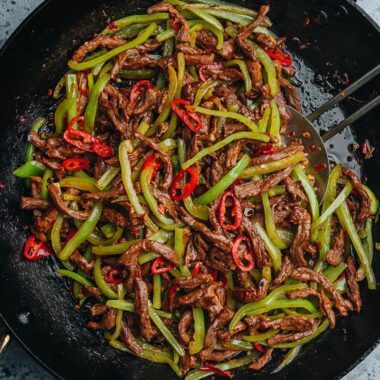
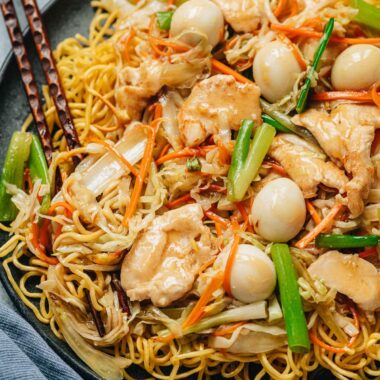

Bettina
Hi Maggie,
Do you have a favorite brand of soup base? I’m just not sure which would be a good one to start with as I’ve never made it before.
Thank you
Maggie Zhu
My favorite one is the Hai Di Lao Spicy Flavor Hot Pot Seasoning (in my blog post, it’s the picture on the right). It is quite rich and spicy.
The Little Sheep brand is also very good. Their spicy base is slightly milder than Hai Di Lao. So if you’re not into super spicy base, the Little Sheep is a better choice.
You won’t go wrong with either.
Ligaciputra
Awesome! I appreciate your post to this matter. It has been insightful.
Ian Knott Sinclair
Fantastic recipes. Very authentic
David
Maggie, for those of us who live in small mid-western towns, would you tell us what ingredients are the essentials? I’m hoping that the essentials will not be so exotic that we would have to go to an Asian store to find them. Sliced beef, pork, chicken we can get. Tofu we can get, but I’ve never seen tofu puffs or any of the other versions of tofu. “Normal” garden veggies I can find, but daikon radish, Chinese broccoli, lotus, etc. are unknown here. Fish balls? Nope. The only mushrooms I see are white or brown. You see my problem? Any suggestions for simplifying and “mid-westernizing” the ingredients list would be most appreciated.
Lisa
Thank you so much for this post. We love hot pot here in Australia but it never occurred to me to have it as a dinner party. Hopefully with your assistance we may have success with this at home. Sincere gratitude. Lisa
Richard
Thank you for this . The problem I have is how does one tell what the various type of balls contain i.e lobster balls etc as I cannot read Chinese only visually
Maggie Zhu
Unfortunately there’s not a great way to tell unless they also have English label on them. All the balls shape and look similar, plus each shop might have a different variety that has a different color / texture… I guess you can always ask the store stuff. For me, my favorite ones are the balls with fillings (usually a fish or shrimp ball with beef / pork / fish roes) so you can ask the stuff to point out those or any flavors you prefer.
Random
You are such an awesome writer…… Very detailed without dragging it out… I’m a fan… Trying to cook all my favourites from my time in the jing in this post covid barely travelling world…. Have you tried any alternative oils in your sichuan hot pot bases??… I’m wondering if I can get away with a healthier oil choice without compromising… (makes me think of the old recycled oil in sichuan restaurants I always use to hear about living in China) lol
Maggie Zhu
Thanks for your kind words! For the Sichuan hot pot base, you can use any neutral oil. I think avocado oil is nice, so does grapeseed oil.
Carol Ann Hagen
I love the information on your site. Thank you for sharing so much excellent and helpful hot pot information.
Maria [Martinez] Liwanag
Maggie, Thank you so much for this extremely helpful list! You are awesome! I’m planning my very first at home hot pot party – small party 🙂 I’m very lucky to live in the Bay area (Silicon Valley) and we are learning by visiting the various hot pot restaurants to see how they do it as well. Yes, we are close to a Hai Di Lao. I really learned so much from your guide and I am saving it for future reference!!! Thank you again. 🙂